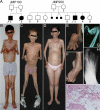An autosomal recessive syndrome of joint contractures, muscular atrophy, microcytic anemia, and panniculitis-associated lipodystrophy
- PMID: 20534754
- PMCID: PMC2936059
- DOI: 10.1210/jc.2010-0488
An autosomal recessive syndrome of joint contractures, muscular atrophy, microcytic anemia, and panniculitis-associated lipodystrophy
Abstract
Context: Genetic lipodystrophies are rare disorders characterized by partial or complete loss of adipose tissue and predisposition to insulin resistance and its complications such as diabetes mellitus, hypertriglyceridemia, hepatic steatosis, acanthosis nigricans, and polycystic ovarian syndrome.
Objective: The objective of the study was to report a novel autosomal recessive lipodystrophy syndrome.
Results: We report the detailed phenotype of two males and one female patient, 26-34 yr old, belonging to two pedigrees with an autosomal recessive syndrome presenting with childhood-onset lipodystrophy, muscle atrophy, severe joint contractures, erythematous skin lesions, and microcytic anemia. Other variable clinical features include hypergammaglobulinemia, hepatosplenomegaly, generalized seizures, and basal ganglia calcification. None of the patients had diabetes mellitus or acanthosis nigricans. Two had mild hypertriglyceridemia and all had low levels of high-density lipoprotein cholesterol. Skin biopsy of an erythematous nodular skin lesion from one of the patients revealed evidence of panniculitis. The lipodystrophy initially affected the upper body but later became generalized involving abdomen and lower extremities as well.
Conclusions: We conclude that these patients represent a novel autoinflammatory syndrome resulting in joint contractures, muscle atrophy, microcytic anemia, and panniculitis-induced lipodystrophy. The molecular genetic basis of this disorder remains to be elucidated.
Figures


References
-
- Garg A 2004 Acquired and inherited lipodystrophies. N Engl J Med 350:1220–1234 - PubMed
-
- Tanaka M, Miyatani N, Yamada S, Miyashita K, Toyoshima I, Sakuma K, Tanaka K, Yuasa T, Miyatake T, Tsubaki T 1993 Hereditary lipo-muscular atrophy with joint contracture, skin eruptions and hyper-γ-globulinemia: a new syndrome. Intern Med 32:42–45 - PubMed
-
- Yamada S, Toyoshima I, Mori S, Tsubaki T 1984 [Sibling cases with lipodystrophic skin change, muscular atrophy, recurrent skin eruptions, and deformities and contractures of the joints. A possible new clinical entity]. Rinsho Shinkeigaku 24:703–710 - PubMed
-
- Oyanagi K, Sasaki K, Ohama E, Ikuta F, Kawakami A, Miyatani N, Miyatake T, Yamada S 1987 An autopsy case of a syndrome with muscular atrophy, decreased subcutaneous fat, skin eruption and hyper γ-globulinemia: peculiar vascular changes and muscle fiber degeneration. Acta Neuropathol 73:313–319 - PubMed
Publication types
MeSH terms
Grants and funding
LinkOut - more resources
Full Text Sources
Medical

